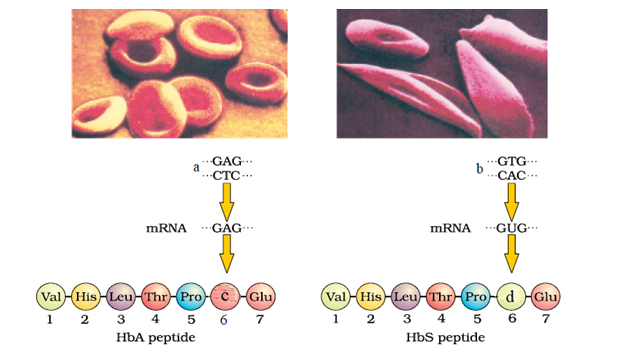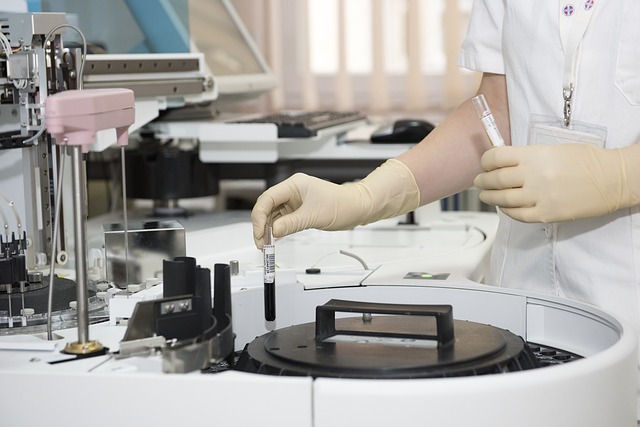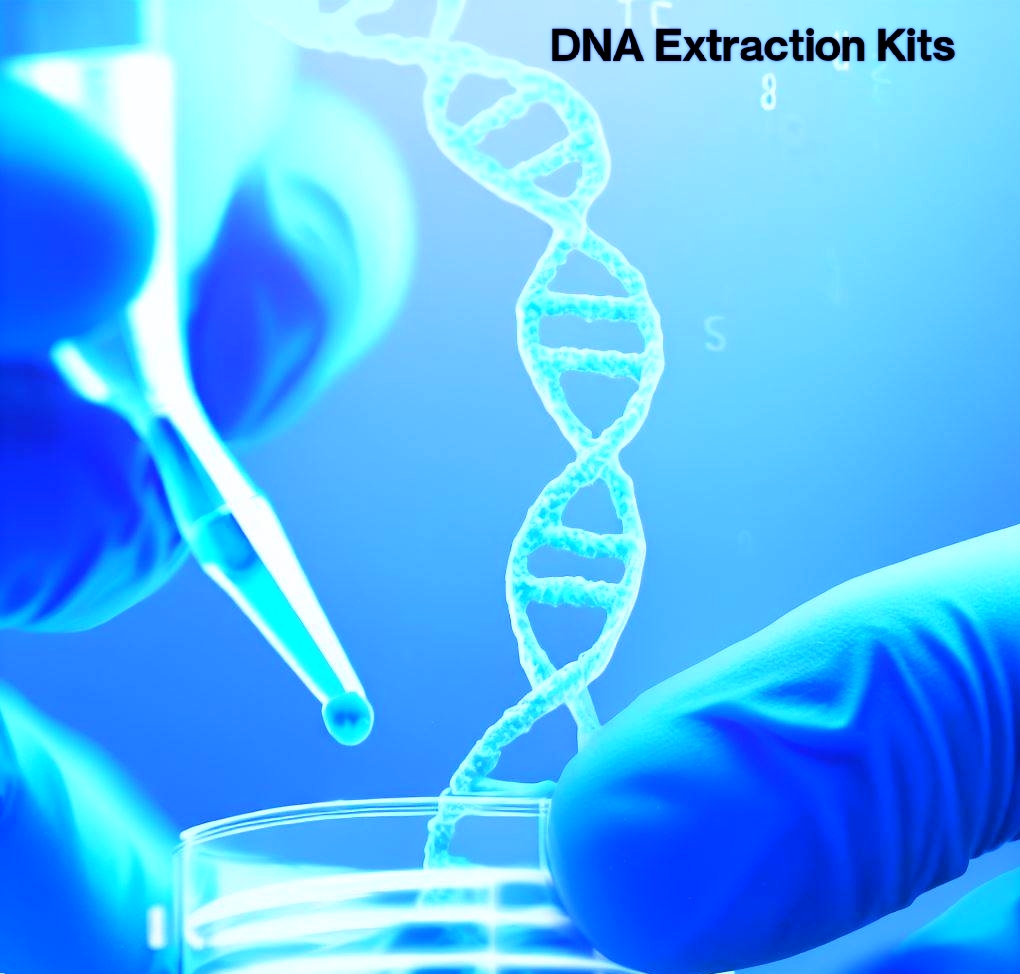DNA Extraction Kits:
A DNA extraction kit comprises a set of reagents and consumables designed to isolate DNA from biological samples. These kits are widely employed in molecular biology and forensics to prepare DNA for various analytical procedures, including PCR, sequencing, and cloning.
learn the mechanism of DNA replication
The components typically found in DNA extraction kits are as follows:
Buffers: Utilized to maintain the extraction solution’s pH and assist in DNA dissolution.
Reagents: Facilitate cell lysis and DNA precipitation.
Consumables: Include tubes, pipettes, and tips required for the extraction process.
Various biological samples, such as blood, tissue, plants, and bacteria, can be used with DNA extraction kits. Although the specific steps in DNA extraction may differ based on the kit and sample type, most kits generally follow these common steps:
- Cell lysis: Cells are broken open, liberating the DNA. This can be achieved mechanically (e.g., using a blender or homogenizer) or enzymatically (using enzymes like proteinase K).
2. Precipitation: DNA is precipitated from the solution using a salt or alcohol solution, aiding in the removal of proteins and cellular debris.
3. Purification: The DNA is purified using methods like centrifugation, electrophoresis, or chromatography, eliminating any remaining contaminants to obtain pure DNA.
DNA extraction kits are valuable tools for molecular biologists and forensic scientists, offering several advantages:
– Ease of use: Most kits come with detailed instructions, making them accessible even to beginners.
– Efficiency: DNA can be extracted quickly and efficiently from samples using these kits.
– Reliability: DNA extraction kits consistently yield high-quality DNA.
However, they also have some limitations, which should be considered:
Cost: DNA extraction kits can be expensive, particularly for high-throughput applications.
Time consumption: Working with DNA extraction kits can be time-consuming, especially for large or complex samples.
Potential DNA damage: Incorrect use of the kits may lead to DNA damage or the introduction of contaminants.
To maximize the benefits and minimize the drawbacks, users should carefully follow the provided instructions and opt for high-quality kits.
Overall, DNA extraction kits remain invaluable tools in the field of molecular biology and forensics, though awareness of their benefits and limitations is crucial prior to utilization.
DNA Extraction Kits: Reagents
DNA extraction kits typically consist of a diverse array of reagents, including:
Buffers: Maintaining the pH of the extraction solution and aiding in DNA dissolution.
Reagents: Responsible for breaking open cells and precipitating the DNA.
Chaotropic agents: Disrupting the structure of proteins and cellular debris, facilitating DNA extraction.
Denaturing agents: Breaking the double helix structure of DNA, converting it into a single-stranded form for easier handling.
Detergent: Used to break open cell membranes and promote cell lysis.
Enzymes: Assisting in the digestion of proteins and cellular debris, simplifying DNA extraction.
Salts: Precipitating the DNA and aiding in the removal of contaminants.
Storage buffer: Utilized for the storage of extracted DNA.
The specific combination of reagents in a DNA extraction kit may vary based on the kit type and the sample being processed. However, most kits typically include a selection of the mentioned reagents.
Some of the most commonly used reagents in DNA extraction kits are:
Proteinase K: An enzyme that effectively digests proteins without damaging the DNA, making it a common reagent in DNA extraction kits.
SDS (Sodium Dodecyl Sulfate): A detergent effective at breaking open cell membranes and promoting cell lysis without harming the DNA.
TE buffer (Tris-EDTA buffer): A neutral buffer widely used in molecular biology to maintain the pH of the extraction solution.
Ethanol: A solvent commonly employed to precipitate DNA without causing damage.
The judicious use of these reagents ensures efficient and uncontaminated DNA extraction. It is important to exercise caution, as some of these reagents may pose hazards.
Following safety instructions diligently is crucial when handling DNA extraction kits.
Steps for Using DNA Extraction Kits:
- Prepare the Sample: Begin by preparing the sample, which may involve homogenization, cell lysis, or contamination removal. The specific steps vary based on the kit and sample type.
- Add Extraction Reagents: Once the sample is prepared, add the extraction reagents specific to the chosen kit.
- Incubate the Sample: Allow the sample to incubate for the designated period, varying according to the kit used.
- Centrifuge the Sample: After incubation, centrifuge the sample to separate the DNA from other components.
- Precipitate the DNA: Precipitate the DNA out of the solution to remove any remaining contaminants.
- Resuspend the DNA: Resuspend the DNA in a buffer to rehydrate it for easier handling.
- Quantify the DNA: Measure the DNA quantity to ensure sufficient DNA for the intended application.
- Store the DNA: Preserve the DNA in a buffer at a cool temperature to prevent degradation.
Using DNA Extraction Kits:
Follow Instructions Carefully: Adhere to the kit’s instructions to ensure efficient and clean DNA extraction.
Use High-Quality Reagents: Employ high-quality reagents to avoid DNA contamination.
Avoid Over mixing the Sample: Be cautious not to over-mix the sample, as it can damage the DNA.
Avoid Vortexing the Sample: Refrain from Vortexing the sample, as it can shear the DNA.
Optimize Precipitation Time: Precipitate the DNA for the correct duration to avoid damaging the DNA.
Resuspend DNA Gently: Carefully resuspend the DNA to prevent shearing.
Properly Store the DNA: Store the DNA at a cool temperature to maintain its integrity and prevent degradation.
By adhering to these guidelines, you can enhance the success of your DNA extraction experiments and ensure reliable results.
Is DNA extraction Kits safer:
DNA extraction kits are generally considered safe for use; however, it is vital to exercise caution by following instructions diligently and using high-quality reagents. Some reagents employed in these kits can be hazardous, necessitating proper safety measures to avoid exposure.
Here are essential safety precautions when using DNA extraction kits:
Wear Protective Gear: Use gloves and eye protection to shield against potential contact with hazardous reagents.
Work in a Well-Ventilated Area: Ensure adequate ventilation to prevent inhalation of any harmful fumes.
Proper Waste Disposal: Dispose of waste materials according to the kit’s provided instructions.
Thoroughly Wash Hands: After completing the procedure, thoroughly wash your hands to eliminate any residues from the skin.
By adhering to these safety precautions, the risk of injury during DNA extraction can be minimized.
Additional tips for safe DNA extraction:
Careful Reading of Instructions: Thoroughly read the instructions to understand potential risks and implement necessary precautions.
Utilize High-Quality Reagents: Ensure the use of high-quality reagents to avoid DNA contamination.
Avoid Overmixing: Refrain from excessive sample mixing to prevent DNA damage.
Avoid Vortexing: Do not vortex the sample to avoid shearing the DNA.
Optimize Precipitation Time: Precipitate DNA for the appropriate duration to avoid damage.
Gentle DNA Resuspension: Handle DNA resuspension gently to prevent shearing.
Appropriate DNA Storage: Store DNA at a cool temperature to maintain its stability and prevent degradation.
By observing these guidelines, the safety of DNA extraction experiments can be maximized, ensuring reliable and hazard-free outcomes.
Price of DNA extraction Kits:
When considering DNA extraction kits, their cost can vary significantly based on the type of kit, processing capacity, and brand. Generally, these kits are priced ranges in between approximately $50 to $500.
However, while cost is a consideration, other factors such as kit quality, ease of use, and intended application are crucial in making an informed decision.
Some important factors to keep in mind when selecting a DNA extraction kit:
- Type of Sample: Some kits are tailored for specific sample types, such as blood, tissue, or plants.
- Intended Application: Different kits are designed for specific applications, like PCR, sequencing, or cloning.
- Ease of Use: The simplicity and user-friendliness of the kit can be significant, especially for inexperienced users.
- Cost: While cost is a factor, it’s important to strike a balance between price and kit quality.
To ensure a wise choice, reading reviews and feedback on various kits can be valuable in selecting the most suitable one for your needs. By considering these factors, you can make an informed decision and select a DNA extraction kit that meets your requirements effectively.









